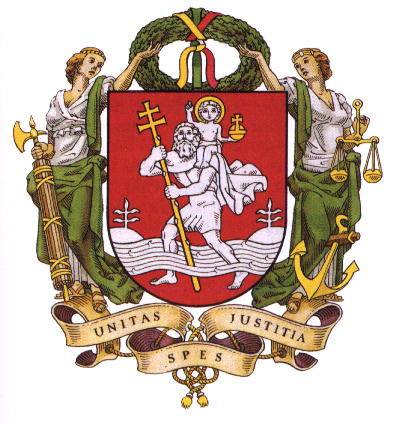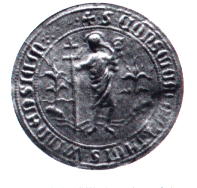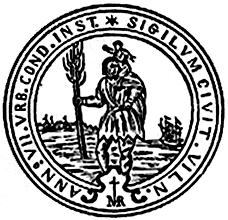Vilnius (city)
Lithuania heraldry portal
This page is part of the Lithuania heraldry portal |
Heraldry of the World |
|
Civic heraldry:
|
Other heraldry: |
VILNIUS
County : Vilnius
Official blazon
Origin/meaning
Vilnius is known since 1323 in written sources and was the capital of Lituania in the middle of the 14th century. On March 22, 1387 Vilnius was granted city rights.
The oldest known seal of the city dates from 1444 and shows St.Christopher, the patron saint of the city. The saint is shown to carry Jesus across the water. The saint carries a double-cross, which is taken from the personal arms of Prince Jogaila, who granted the city rights.
| The oldest seal of Vilnius |
Later seals all show St. Christopher and Jesus, but the cross gradually is transformed into a pilgrim's staff or, since the 16th century, a tree branch. In 1792 he was carrying a lance and later he also had a sword at his side.
| The arms from the 18th century |
In 1794 the supporters appear for the first time. They represented Justice, holding a pair of scales, and Unity holding Roman fasces. Below the shield an anchor, symbolising Hope was shown.
When Lithuania was conquered by Russia in 1795 the arms showed a divided shield with the Russian eagle in the upper field and the old arms in the lower filed. In 1809 only the Russian eagle was used.
In 1809 the arms were again changed. Vilnius was now granted a knight on a galloping horse, derived from the old National arms of Lithuania. These arms were used until the beginning of the 20th century.
From 1920-1940 the old arms were restored, but all arms were prohibited after Lithuania was incorporated into the Soviet Union. In 1968 attempts were made to restore the old arms, but that was not allowed. The present arms were granted on April 17, 1991. The arms as shown above are the great arms of the city. The small arms, which are more commonly used, show only the shield itself.
Contact and Support
Partners:
Your logo here ?
Contact us
© since 1995, Heraldry of the World, Ralf Hartemink 
Index of the site
Literature : Rimsa, 1998















